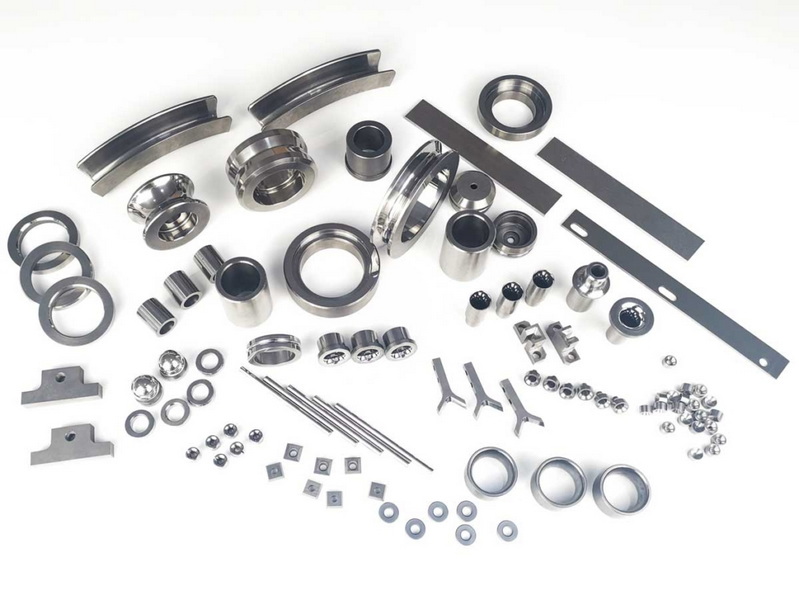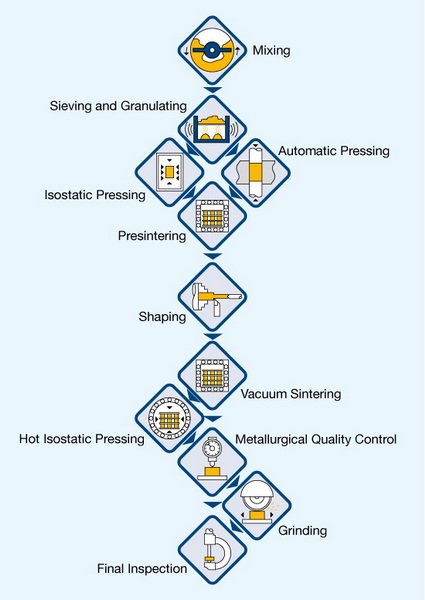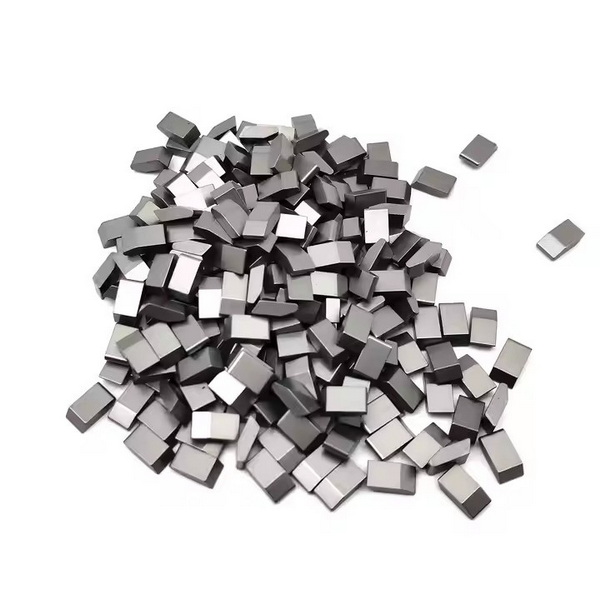Content Menu
● Introduction to Carbide Products Inc. Henderson KY
● Carbide Manufacturing Process
>> 1. Raw Material Preparation
>> 2. Mixing and Milling
>> 3. Pressing and Shaping
>> 4. Sintering
>> 5. Post-processing
● Advanced Techniques in Carbide Manufacturing
● Carbide Products Inc. Henderson KY: Specialized Manufacturing
● Applications of Carbide Components
● Innovations and Future Directions
>> Emerging Trends in Carbide Technology
● Quality Control and Assurance
● Conclusion
● Frequently Asked Questions
>> 1. What is the primary method used for manufacturing carbide components?
>> 2. What are the key properties of tungsten carbide?
>> 3. What industries commonly use carbide components?
>> 4. How does the ratio of tungsten carbide to binder affect the final product?
>> 5. Can carbide components be recycled?
● Citations:
Henderson, Kentucky, is home to several advanced manufacturing facilities, including those specializing in carbide products. Carbide components are crucial in various industries due to their exceptional hardness and wear resistance. This article will delve into the manufacturing process of carbide components, focusing on the techniques and technologies employed by companies like Carbide Products Inc. in Henderson, KY.

Introduction to Carbide Products Inc. Henderson KY
Carbide Products Inc., located in Henderson, KY, is renowned for its expertise in precision machining and manufacturing of carbide components. With a legacy spanning over eight decades, the company has established itself as a trusted partner for businesses across multiple sectors, including automotive, aerospace, and industrial manufacturing. Their commitment to innovation and craftsmanship ensures that their products meet the highest standards of quality and performance.
Carbide Manufacturing Process
The production of carbide components involves several key steps, primarily using powder metallurgy. Here's an overview of the process:
1. Raw Material Preparation
The journey begins with the selection and preparation of high-quality tungsten carbide powder and a binder metal, typically cobalt or nickel. The ratio of tungsten carbide to the binder is crucial, as it determines the final hardness and toughness of the product.
2. Mixing and Milling
The powders are mixed thoroughly to ensure uniform distribution. This step is critical for achieving consistent properties throughout the final product. Ball milling is often used to reduce particle size, enhancing the sinterability of the mixture.
3. Pressing and Shaping
The powder mixture is then compacted into a die under high pressure to form a green compact. The shape of the die determines the final form of the carbide component.
4. Sintering
The green compact is heated in a furnace at temperatures between 1400°C to 1600°C. During sintering, the binder melts and binds the tungsten carbide particles together, creating a solid and hard composite.
5. Post-processing
After sintering, the carbide components undergo various machining processes such as grinding, EDM (Electrical Discharge Machining), and polishing to achieve precise dimensions and surface finish.
Advanced Techniques in Carbide Manufacturing
In recent years, carbide manufacturing has seen significant advancements, including the adoption of new technologies and techniques:
- 3D Printing: Some manufacturers are exploring the use of 3D printing to create complex carbide structures that cannot be produced through traditional methods. This technique allows for greater design flexibility and reduced material waste.
- Nanomaterials: Incorporating nanomaterials into carbide composites can enhance their mechanical properties, such as hardness and toughness. This is achieved by reducing the particle size of the tungsten carbide to the nanoscale.
- Advanced Sintering Techniques: Techniques like hot isostatic pressing (HIP) and spark plasma sintering (SPS) offer improved densification and microstructure control, leading to enhanced performance of the carbide components.

Carbide Products Inc. Henderson KY: Specialized Manufacturing
Carbide Products Inc. in Henderson, KY, specializes in high-precision machining and manufacturing of complex carbide components. Their expertise includes:
- CNC Machining: Utilizing advanced CNC machines for precise cutting and shaping.
- EDM: Employing Electrical Discharge Machining for intricate geometries.
- Grinding: Achieving high surface finish through advanced grinding techniques.
Applications of Carbide Components
Carbide components are essential in various industries due to their exceptional properties:
- Industrial Tools: Cutting tools, wear parts, and dies.
- Military Applications: Armor plating and projectiles.
- Metallurgy: High-wear components in furnaces and smelting equipment.
- Oil Drilling: Drill bits and wear-resistant parts.
- Mining Tools: Picks and drill bits.
- Construction: Wear parts in heavy machinery.
Innovations and Future Directions
The future of carbide manufacturing is promising, with ongoing research into new materials and processes. Innovations such as the use of advanced binders and the integration of carbide with other materials (e.g., diamond or cubic boron nitride) are expected to further enhance the performance and versatility of carbide components.
Emerging Trends in Carbide Technology
- Sustainability: There is a growing focus on sustainable manufacturing practices, including recycling and reusing carbide materials to reduce environmental impact.
- Material Science Advances: Research into new carbide compositions and structures aims to improve thermal conductivity, corrosion resistance, and mechanical strength.
- Digitalization: The integration of digital technologies such as AI and IoT in manufacturing processes is expected to enhance efficiency and precision.
Quality Control and Assurance
To ensure that carbide components meet the required standards, rigorous quality control measures are implemented throughout the manufacturing process. This includes:
- Material Inspection: Verification of raw materials to ensure purity and consistency.
- Process Monitoring: Continuous monitoring of sintering and machining processes to maintain precise control over product properties.
- Final Inspection: Comprehensive testing of finished products for dimensions, hardness, and surface finish.
Conclusion
The manufacturing of carbide components in Henderson, KY, by companies like Carbide Products Inc. involves a sophisticated process that combines advanced technology with skilled craftsmanship. The use of powder metallurgy ensures high-quality products with precise dimensions and exceptional wear resistance. As industries continue to evolve, the demand for carbide components will remain strong, driven by their durability and performance.

Frequently Asked Questions
1. What is the primary method used for manufacturing carbide components?
The primary method used for manufacturing carbide components is powder metallurgy, which involves mixing tungsten carbide powder with a binder metal, compacting the mixture, and then sintering it at high temperatures.
2. What are the key properties of tungsten carbide?
Tungsten carbide is renowned for its exceptional hardness, wear resistance, thermal stability, corrosion resistance, and high tensile strength.
3. What industries commonly use carbide components?
Carbide components are widely used in industrial tools, military applications, metallurgy, oil drilling, mining tools, and construction due to their durability and performance.
4. How does the ratio of tungsten carbide to binder affect the final product?
The ratio of tungsten carbide to the binder metal (e.g., cobalt) affects the hardness and toughness of the final product. A higher binder content typically results in a tougher but softer material, while a lower binder content yields a harder but less tough material.
5. Can carbide components be recycled?
Yes, carbide components can be recycled. Worn-out tools and scrap material can be reclaimed and reused, reducing waste and conserving resources.
Citations:
[1] https://www.carbide-products.com/blog/tungsten-carbide-production-process/
[2] https://generalcarbide.com
[3] https://www.carbide-products.com/blog/how-is-carbide-made/
[4] https://www.carbide-products.com/blog/carbide-nozzle-process/
[5] http://www.carbidetechnologies.com/faqs/
[6] https://onmytoolings.com/how-are-carbide-inserts-made/
[7] https://en.wikipedia.org/wiki/Tungsten_carbide
[8] https://www.carbidepros.com/history
[9] https://www.retopz.com/57-frequently-asked-questions-faqs-about-tungsten-carbide/
[10] https://www.carbidepros.com
[11] https://nylene.com/company-overview/our-history/
[12] https://www.thomasnet.com/suppliers/kentucky/all-cities/carbide-tools-86081403
[13] https://www.dnb.com/business-directory/company-information.manufacturing.us.kentucky.henderson.html
[14] https://www.thomasnet.com/suppliers/kentucky/all-cities/high-production-machining-96072624
[15] https://cedky.com/cdn/11295_Manufacturing_Facilities_in_Kentucky.pdf
[16] https://www.taubensee.com/company/our-facilities/henderson-ky-location/
[17] https://www.mapquest.com/us/kentucky/audubon-metals-5531775
[18] https://cedky.com/cdn/kyedc/Chemical_Industry_Report.pdf?13&100
[19] https://www.linkedin.com/company/carbide-products-inc.
[20] https://cedky.com/cdn/kyedc/Chemical_Industry_Report.pdf?13
[21] https://www.thomasnet.com/suppliers/kentucky/all-cities/contract-manufacturing-17871203
[22] https://www.ace-mold.com/gibbs-die-casting-henderson-ky/
[23] https://www.istockphoto.com/photos/tungsten-carbide
[24] https://stock.adobe.com/search?k=tungsten+carbide
[25] https://pennunitedcarbide.com
[26] https://www.shutterstock.com/search/tungsten-carbide
[27] https://www.sciencedirect.com/science/article/pii/S2238785425003291
[28] https://www.shutterstock.com/search/production-carbide?image_type=photo&page=2
[29] https://www.gettyimages.com.au/photos/tungsten-carbide?page=2
[30] https://www.innovativecarbide.com
[31] https://stock.adobe.com/search/images?k=carbide+cutting
[32] https://www.istockphoto.com/photos/tungsten-carbide?page=2
[33] https://www.haascnc.com/index.html
[34] https://www.pinterest.com/pin/solarsoncarbidemanufacturing-process-of-tungsten-carbide-products--508766089138084882/
[35] https://www.tungco.com/insights/blog/frequently-asked-questions-used-tungsten-carbide-inserts/
[36] https://www.practicalmachinist.com/forum/threads/carbide-question.86468/post-164612
[37] https://www.psmindustries.com/ferro-tic/questions-about-steel-carbide-bonded-machining
[38] https://carbidetools.nz/faqs/
[39] https://tuncomfg.com/about/faq/
[40] https://rocklinmanufacturing.com/blog/2022/5/18/rocklin_mfg/frequently_asked_questions_about_rocklinizing/ar/94/
[41] https://www.sandvik.coromant.com/en-us/services/recycling/faq-carbide-recycling
[42] https://www.sandvik.coromant.com/en-gb/services/recycling/faq-carbide-recycling
[43] https://www.linkedin.com/pulse/3-questions-tungsten-carbide-buttons-shijin-lei
[44] https://www.boroncarbideparts.com/faqs/index.html
[45] https://www.everloy-cemented-carbide.com/en/knowledge/faq.html
[46] https://www.ctis.biz/post/top-5-signs-your-carbide-tools-need-reconditioning
[47] https://nepis.epa.gov/Exe/ZyPURL.cgi?Dockey=94008WXR.TXT
[48] https://www.linkedin.com/company/carbide-industries-llc
[49] https://www.carbidellc.com
[50] https://cedky.com/cdn/kyedc/Motor%20Vehicle%20Related%20Facilities%20in%20Kentucky_Oct2023.pdf
[51] https://www.mmc-carbide.com/sea/technical_information/tec_guide/tec_guide_carbide
[52] https://www.alamy.com/stock-photo/tungsten-carbide.html
[53] https://www.latimes.com/archives/la-xpm-1987-04-28-fi-2279-story.html
[54] https://www.istockphoto.com/photos/carbide
[55] https://www.istockphoto.com/photos/carbide-tools
[56] https://www.youtube.com/watch?v=dkFuZVBTTS0
[57] https://www.generalcarbide.com/wp-content/uploads/2019/04/GeneralCarbide-Designers_Guide_TungstenCarbide.pdf
[58] https://infinitytools.com/blogs/blog/carbide-101
















